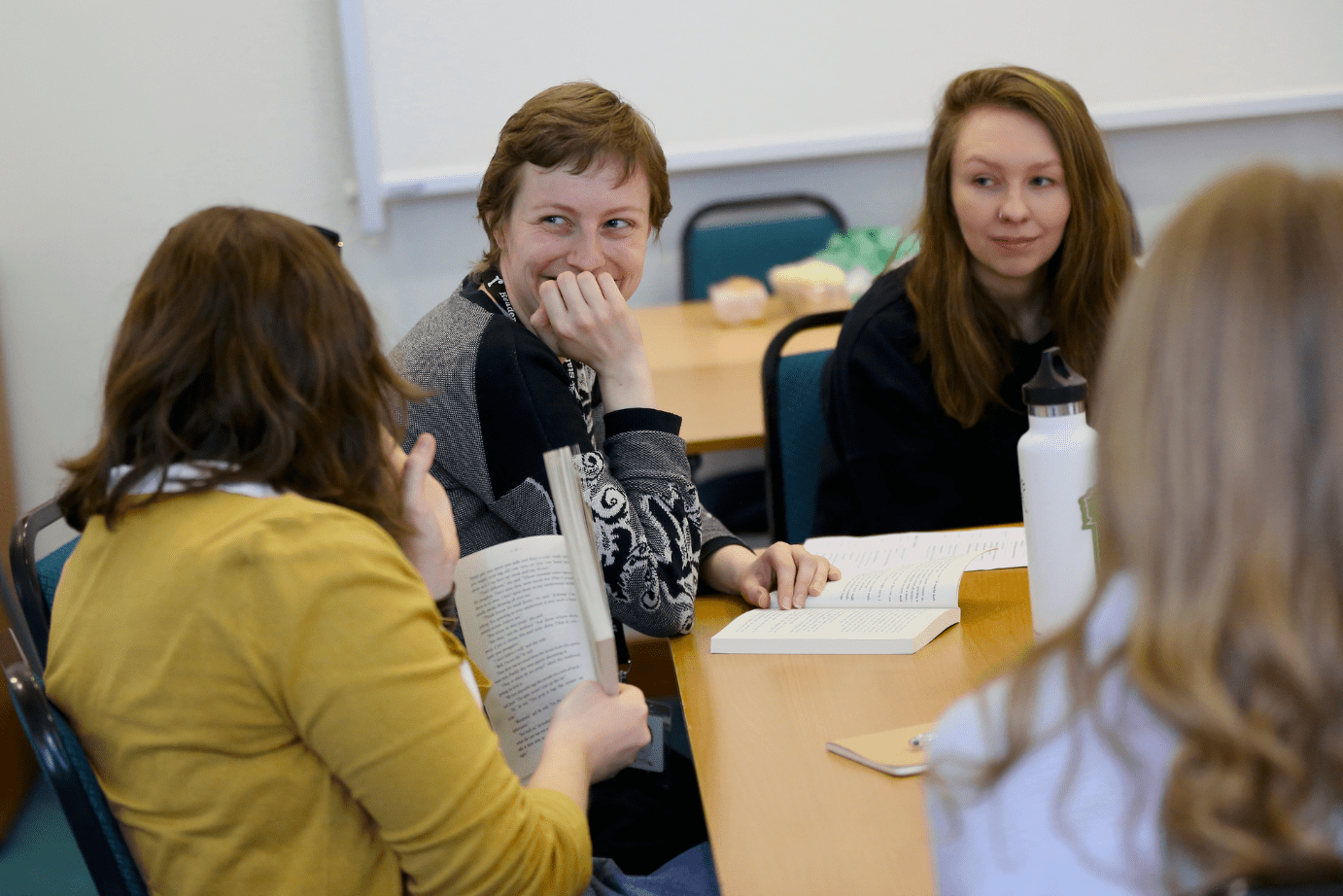Shared Reading in the Workplace: what is it, and how can it help mitigate workplace stress?
With a third of Gen Z workers taking sick days due to stress last year the UK’s biggest Shared Reading charity The Reader explores three cases where Shared Reading in the Workplace is making a real difference to employee wellbeing - in the office and beyond...
From offering staff a safe space to discuss ‘difficult’ topics to bringing teams together on away days, national charity The Reader has uncovered real-life examples of how Shared Reading in the Workplace is actively helping to improve wellbeing in the office.
The Liverpool-based arts and wellbeing charity has been running Shared Reading groups across the UK for more than 20 years in a wide range of settings including prisons, hospitals, mental health trusts, rehabilitation centres and community groups.
But it also offers Shared Reading in the Workplace which provides the opportunity to bring groups of colleagues together in a welcoming, relaxed, creative space in which they can connect with literature and to each other.
As a tool with a proven methodology developed across 20 years its application in the workplace can have really powerful results. These include:
- Supporting employee wellbeing in the workplace
- Building connection and collaboration between teams
- Developing listening and leadership skills
- Enabling employees to discuss equity and inclusion in a safe and meaningful way
One innovative Wirral-based charity which supports young people aged 14 – 35, with anxiety and depression, uses Shared Reading to bring different teams together on staff away days.

George Hawkins, Joy Project Director at Open Door in Birkenhead, trained as a group leader with The Reader and leads the sessions.
He said: “As we offer peer-led mental health and wellbeing support for young people, we’re very much wanting to make sure our staff team also benefit from this kind of support personally in the workplace too.
“For me Shared Reading builds room and creates space for thoughtful, genuine and deep conversation and connection. It gives room for people’s heartfelt reactions, good collaboration and mutual understanding. In the workplace this has definite value and bridges the gap to go beyond surface level chit-chat and leads to quite profound conversations.”
At the core of building an effective and resilient workforce is connection and collaboration – the ability for colleagues to be able to relate to each other in a deeper way, to allow for difference of opinion – to hold space for resolution and collaboration and to create a safe environment in which to do so. How can Shared Reading make a difference in practice?

Jess Harrison, Data Training and Engagement Lead at The Reader, who co-founded a Shared Reading group for staff in 2021 reading George Eliot’s controversial final novel Daniel Deronda said: “I feel our group is a safe space for people to talk about difficult and complex subjects. The book explores problematic attitudes to different communities within Victorian society which still impact us today. The novel has challenging viewpoints expressed by some characters and the group provides an opportunity to name, confront and address them.”
Co-founder Jen Jarman, Head of Monitoring and Evaluation at The Reader, added: “In an age of cancel culture and where there’s a lot of outrage on social media it gives that safe space for staff to discuss difficult topics that are very ‘live’ in today’s society - and examines a way to discover and build on commonalities.
“Shared Reading offers a time when staff can step away from work and it helps with workplace relationships by bringing about a sense of closeness. In a one-to-one context with a line manager, it can also provide an opportunity to raise difficult topics or conversations in a less confrontational way.”
Shared Reading can also have a major impact on an individual’s personal life.

Jamiejohn Anderson, Executive Director of Operations at National Museums Liverpool first experienced a Shared Reading in the Workplace taster session with other members of the leadership team. He said:
“It was so therapeutic and revelatory that it inspired me to pick up a book and read to my mum who had recently been admitted into a hospice where she was receiving end-of-life care. All of my family had defined roles with mum, and Shared Reading became our special thing, and it was meaningful and powerful.”
The Reader works with organisations across the country where staff attend Shared Reading sessions alongside the people they support and consistently hears that it helps them to build better relationships, leads to greater job satisfaction and improves their wellbeing.
In last year’s Feedback survey from staff who attend Shared Reading sessions with people they support in a mental health setting, 100% say it makes their job more enjoyable; 100% feel it is good for their own wellbeing and 89% say their relationship with patients is better because of the group.
How it works
- Shared Reading is a creative, live experience that can bring lightness and relaxation alongside deep connections and meaningful discussions.
- Reading aloud together creates a powerful way of engaging diverse groups and removing barriers to entry, including perceptions of reading based on past experiences.
How can The Reader bring Shared Reading to your workplace
- Shared Reading sessions can be run weekly or monthly and delivered by Reader staff, or the charity can create a training and support package to enable staff at an organisation to deliver groups themselves.
- It can also offer taster or one-off sessions for groups who may want a Shared Reading session less frequently or wish to hold a Shared Reading session to focus on a particular theme or issue such as conflict resolution, confidence building or to explore texts that help facilitate difficult conversations.
- Central to this is that a space is created where people – regardless of age, background or ability – feel safe, valued and listened to.
For further information to find out more about how to experience Shared Reading to your workforce please contact development@thereader.org.uk
Workplace stress - key facts and stats:
- A third of workers under the age of 25 were more likely to need time off because of poor mental health caused by stress than any other age group according to a survey released by Mental Health UK in January 2025. Among older workers aged 45 and above, just one in 10 needed time off last year due to stress.
- Stress is one of the biggest contributors to workplace absences in the UK and has become such a significant threat that the World Health Organisation (WHO) has classified it as the health epidemic of the 21st century.
- Stress manifests in various ways and can affect an employee’s emotional wellbeing and mental health. Symptoms can range from reduced work performance, social withdrawal to emotional outbursts, poor concentration and reduced confidence.
- The estimated yearly cost of stress and poor mental health for UK employers is estimated between £33bn and £42bn.
- The latest statistics, covering April 2023-March 2024, were released in November 2024. This included a specific analysis of work-related stress, depression and anxiety. Drawing from the Labour Force Survey (LFS) data, the Health and Safety Executive (HSE) estimates that 776,000 workers are suffering from both new and long-standing cases of stress, depression or anxiety.
- This is a rate of 2,290 cases per 100,000 workers and accounted for 16.4 million working days being lost. The LFS is a national survey of 23,000 households run by the Office of National Statistics (ONS).
Find out more here.
Share
Related Articles

Two volunteer opportunities have arisen to train and work with UK Shared Reading charity The Reader in Halton
The Reader is recruiting two volunteers to lead two Shared Reading groups in Widnes and Halton Lea Library within Liverpool…

Liverpool ONE unveils book corners in partnership with The Reader to help boost literacy across the city
Liverpool ONE has unveiled a collection of ‘reading corners’ in a bid to help boost literacy levels among local people.…

Shared Reading in the Workplace Q&A – National Museums Liverpool (NML)
For Jamiejohn Anderson, Executive Director of Operations, at National Museums Liverpool Shared Reading in the workplace had a powerful yet…


